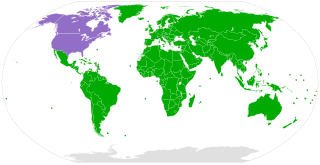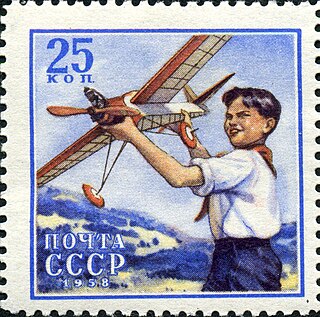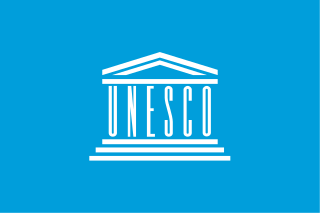
The United Nations Convention on the Rights of the Child is an international human rights treaty which sets out the civil, political, economic, social, health and cultural rights of children. The convention defines a child as any human being under the age of eighteen, unless the age of majority is attained earlier under national legislation.

William Norman McLaren, LL. D. was a Scottish Canadian animator, director and producer known for his work for the National Film Board of Canada (NFB). He was a pioneer in a number of areas of animation and filmmaking, including hand-drawn animation, drawn-on-film animation, visual music, abstract film, pixilation and graphical sound. McLaren was also an artist and printmaker, and explored his interest in dance in his films.

Children's Day is a commemorative date celebrated annually in honour of children, whose date of observance varies by country. In 1925, International Children's Day was first proclaimed in Geneva during the World Conference on Child Welfare. Since 1950, it is celebrated on 1 June in many countries, which follow the suggestion from Women's International Democratic Federation. World Children's Day is celebrated on 20 November to commemorate the Declaration of the Rights of the Child by the UN General Assembly on 20 November 1959. In some countries, it is Children's Week and not Children's Day. The Sikhs celebrate Children Day on 20 December to 27 December.
The year 1985 was proclaimed by the United Nations as the International Youth Year (IYY). It was held to focus attention on issues of concern to and relating to youth. The proclamation was signed on 1 January 1985, by United Nations Secretary General Javier Pérez de Cuéllar.
The United Nations World Summit for Children was held in the United Nations Headquarters in New York City on 29–30 September 1990. The summit had the then-largest-ever gathering of heads of state and government to commit to a set of goals to improve the well-being of children worldwide by the year 2000. It was the first time a UN conference had set a broad agenda for a wide range of goals in health, education, nutrition and human rights.

International Mother Language Day is a worldwide annual observance held on 21 February to promote awareness of linguistic and cultural diversity and to promote multilingualism. First announced by UNESCO on 17 November 1999, it was formally recognized by the United Nations General Assembly with the adoption of UN resolution 56/262 in 2002.

The International Holocaust Remembrance Day, or the International Day in Memory of the Victims of the Holocaust, is an international memorial day on 27 January that commemorates the victims of the Holocaust, which resulted in the genocide of one third of the Jewish people, along with countless members of other minorities by Nazi Germany between 1933 and 1945, an attempt to implement its "final solution" to the Jewish question. 27 January was chosen to commemorate the date when the Auschwitz concentration camp was liberated by the Red Army in 1945.
The International Board on Books for Young People (IBBY) is an international non-profit organization committed to bringing books and children together. The headquarters of the IBBY are located in Basel, Switzerland.

Katalin Annamária Bogyay is a Hungarian ambassador, diplomat, journalist and the President of the United Nations Association of Hungary since April 2021. She has been a lecturer at the Corvinus University of Budapest since 2022, and teaching at the Hungarian Diplomatic Academy since 2021. In 2021 she founded the Women4Diplomacy movement. She served as the 15th Permanent Representative of Hungary to the United Nations in New York. She is the former Ambassador Extraordinary and Plenipotentiary and Permanent Delegate of Hungary to UNESCO (2009–2014) and the President of the 36th session of UNESCO General Conference (2011–2013).
Every Child is an animated short film produced in 1979 by the National Film Board of Canada in association with UNICEF.
The United Nations Decade for Women was a period from 1975 to 1985 focused on the policies and issues that impact women, such as pay equity, gendered violence, land holding, and other human rights. It was adopted December 15, 1975, by the United Nations General Assembly by Resolution 31/136.
International Day of Zero Tolerance for Female Genital Mutilation is a United Nations-sponsored annual awareness day that takes place on February 6 as part of the UN's efforts to eradicate female genital mutilation. It was first introduced in 2003.
UNICEF, originally called the United Nations International Children's Emergency Fund in full, now officially United Nations Children's Fund, is an agency of the United Nations responsible for providing humanitarian and developmental aid to children worldwide. The organization is one of the most widely known and visible social welfare entities globally, operating in 192 countries and territories. UNICEF's activities include providing immunizations and disease prevention, administering treatment for children and mothers with HIV, enhancing childhood and maternal nutrition, improving sanitation, promoting education, and providing emergency relief in response to disasters.

The United Nations Educational, Scientific and Cultural Organization (UNESCO) is a specialized agency of the United Nations (UN) with the aim of promoting world peace and security through international cooperation in education, arts, sciences and culture. It has 194 member states and 12 associate members, as well as partners in the non-governmental, intergovernmental and private sector. Headquartered in Paris, France, UNESCO has 53 regional field offices and 199 national commissions.
International Day of the Girl Child is an international observance day declared by the United Nations; it is also called the Day of Girls and the International Day of the Girl. October 11, 2012, was the first Day of the Girl Child. The observation supports more opportunity for girls and increases awareness of gender inequality faced by girls worldwide based upon their gender. This inequality includes areas such as access to education, nutrition, legal rights, medical care, and protection from discrimination, violence against women and forced child marriage. The celebration of the day also "reflects the successful emergence of girls and young women as a distinct cohort in development policy, programming, campaigning and research."

Anaïs Barbeau-Lavalette is a Canadian novelist, film director, and screenwriter from Quebec. Her films are known for their "organic, participatory feel." Barbeau-Lavalette is the daughter of filmmaker Manon Barbeau and cinematographer Philippe Lavalette, and the granddaughter of artist Marcel Barbeau.

Shubhavi Arya is an Indian animator and film director.

Armenia was admitted into the United Nations on 2 March 1992, following its independence from the Soviet Union. In December 1992, the UN opened its first office in Yerevan. Since then, Armenia has signed and ratified several international treaties. There are 20 specialized agencies, programs, and funds operating in the country under the supervision of the UN Resident Coordinator. Armenia strengthened its relations with the UN by cooperating with various UN agencies and bodies such as the International Monetary Fund, the World Bank, the World Food Programme, and with the financial institutions of the UN. Armenia is a candidate to preside as a non-permanent member of the UN Security Council in 2031.

Moushira Mahmoud Khattab is an Egyptian politician and diplomat born in 1944. She is serving as the president of the National Council for Human Rights, Egypt's national Human Rights Institution. She previously served as minister of family and population, assistant minister of foreign affairs, Ambassador of Egypt to South Africa, the Czech Republic and Slovakia as well serving in Egypt’s diplomatic missions in Australia, Hungary, Austria and the United Nations in New York City and Vienna. She is also a human rights activist advocating the rights of children and women and the former vice chair and rapporteur of the UN Committee on the Rights of the Child based at the UN Headquarters in Geneva. On 19 July 2016, the Prime Minister of Egypt announced that Moushira Khattab would be Egypt's candidate for the post of UNESCO director-general at the elections due to be held in 2017.
The Declaration and Programme of Action on a Culture of Peace was adopted by the United Nations General Assembly on September 13, 1999. This occurred after ten months of negotiations in the context of preparations for the International Year for the Culture of Peace.













